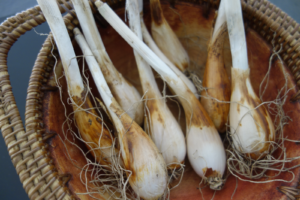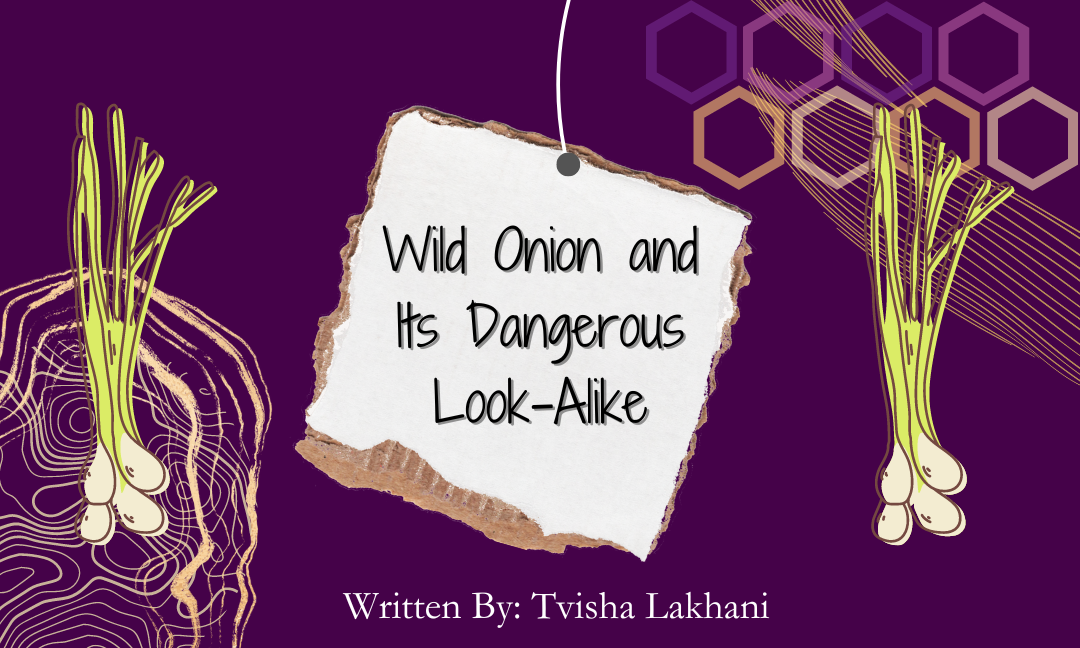Written by: Tvisha Lakhani
Edited by: Julia Georgescu
Designed by: Maahi Jain
Published by: Kiritika Rana
Note: This article is only for general information and should not be used as your only source of information, or as a substitute for your research. If you suspect you have a death camas plant, DO NOT consume it and throw it out immediately. If you have already consumed a death camas, call the Poison Control Centre or 911 IMMEDIATELY.

If it looks like a duck and quacks like a duck, it’s probably a duck. Many people go by this rule, but when dealing with the outdoors, this strategy can be dangerous. One example of this is two species known as wild onion and death camas.
Wild onion, a member of the genus Allium, often grows in springtime in a variety of regions. While there are many different types of wild onions, they all generally have a strong and unique flavour and impart a potent oniony smell. Most wild onions are completely safe to consume and can be used in a plethora of dishes.
On the other hand, the death camas plant is much more sinister. As the name suggests, it is an incredibly toxic plant, with all of its parts being unsafe for human consumption. Death camas poisoning can cause excessive salivation, numbness in the mouth, burning of the lips, extreme thirst, pain in the stomach, diarrhea and vomiting, confusion, slow and/or irregular heartbeat, low blood pressure and body temperature, breathing difficulty, coma, and even death.
By nature, these two plants are vastly different, but by appearance, less so. Both feature a small bulb hidden underneath the dirt and a bloom of small white flowers and long green leaves. Nevertheless, death camas and wild onion do have some subtle, yet key differences.
Wild onion leaves are softer and smoother in relation to the more grass-like feel of death camas leaves. Wild onions also have darker leaves compared to the lighter greens of their counterparts. Another difference to note is that while wild onion leaves have a U-shaped valley, death camases have a V-shaped notch in their leaves. However, the biggest contrast between wild onions and death camas plants is the smell. No matter the species, wild onions smell like an onion, while death camas plants do not.
If you’ve found two onion-like plants that look alike, these are great guidelines to use for distinguishing them. Regardless, please bear in mind that this blog is for generalized information only and further research should always be done before consuming any unknown plant.
Works Cited
Iron Cloud, L., & Iron Cloud, A. (2020, May 28). Wild Onion vs. Death Camas. Lakota Times. https://www.lakotatimes.com/articles/wild-onion-vs-death-camas/
Mitton, J. (2018, March 12). The paradox of toxic nectar and pollen in death camas. Colorado Arts and Sciences Magazine. https://www.colorado.edu/asmagazine/2018/03/12/paradox-toxic-nectar-and-pollen-death-camas
Rocky Mountain Edibles. (2019, June 2). Wild Onion vs Poisonous Lookalike (Death Camas) [Video]. Youtube. https://www.youtube.com/watch?v=P8vz7B0hLC8
Rocky Mountain Edibles. (2021, June 16). A Deeper Look, Death Camas Vs.Wild Onion [Video]. Youtube. https://www.youtube.com/watch?v=gSJpklvVx34
Shaw, H. (2020, July 4). How to Harvest Wild Onions. Hunter Angler Gardener Cook. https://honest-food.net/how-to-harvest-wild-onions/
Sycamore, S. (2022, July 19). How to Identify Edible Wild Onions—Field Garlic, Ramps, Wild Leeks and More. Sycamore Garden. https://foraging.sycamore.garden/plants/edible-wild-onions-garlic
Ulimw. (2020). Allium obliquum bulbs Scharfer Gelblauch Zwiebeln Ulimw 2020 [Image]. Wikimedia Commons. https://commons.wikimedia.org/wiki/File:Allium_obliquum_bulbs_Scharfer_Gelblauch_Zwiebeln_Ulimw_2020.jpg
US Forest Service. (n.d.). Death Camas. United States Department of Agriculture. https://www.fs.usda.gov/detail/whiteriver/learning/?cid=fsm9_019086

